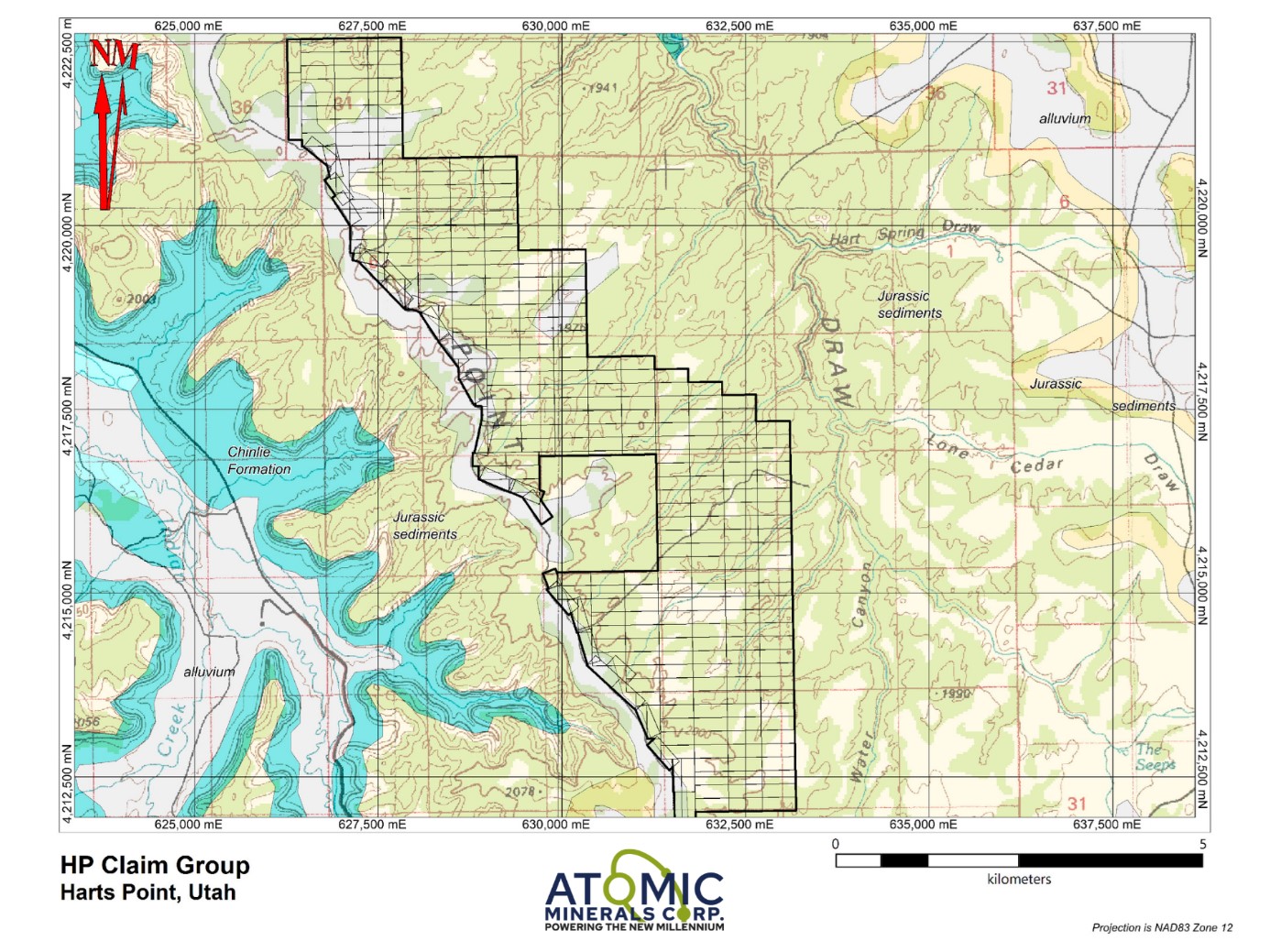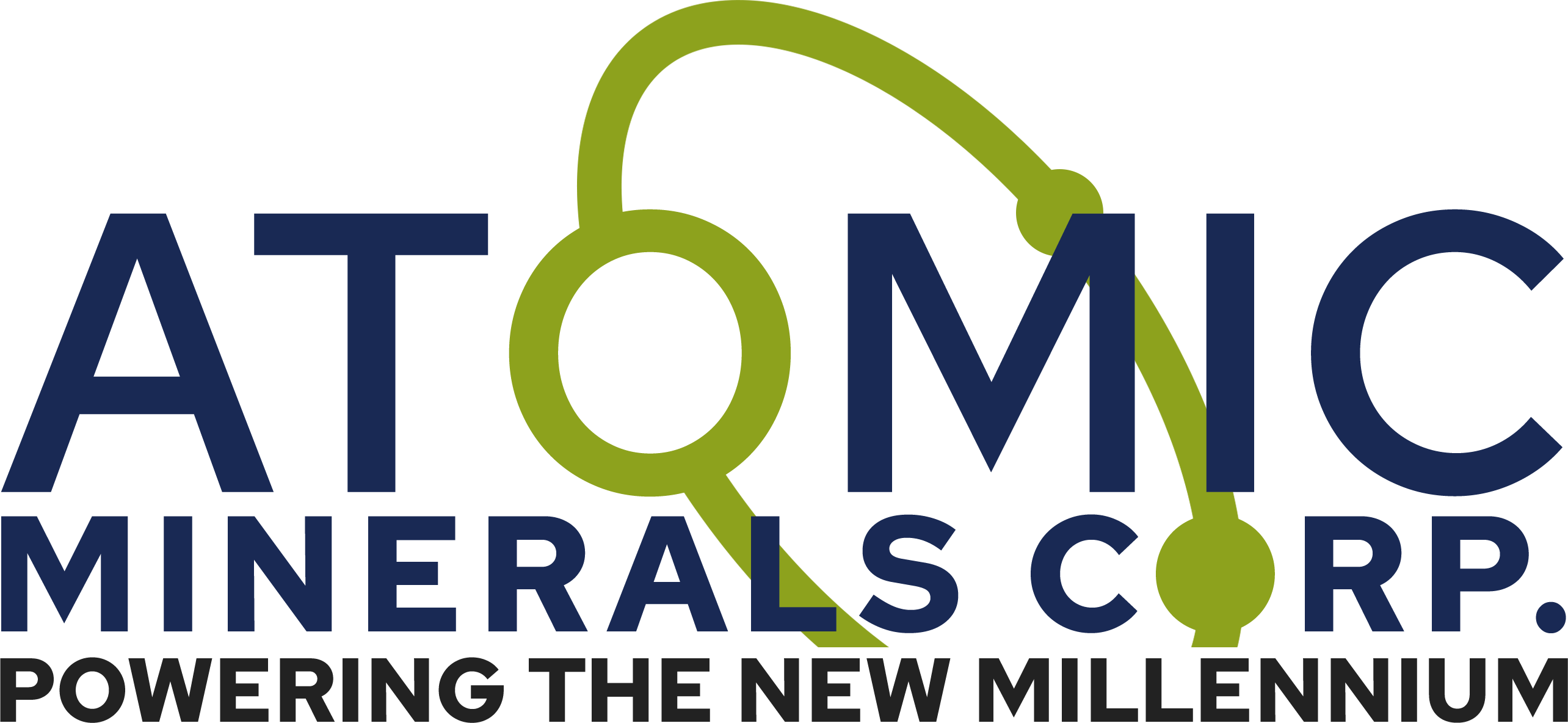Harts Point
Overview
Atomic Minerals Harts Point Project lies on the eastern flank of the southern extension of Gibson Dome, a non-diapiric salt anticline, in San Juan County, Utah near the northeastern limits of the White Canyon Mining District. Four mines located about seven miles west of the Harts Point Project, the Jean, Moki, Lavender, and Conglomerate, in upper Indian Creek shipped a total of 42,000 tons of material hosted by Chinle Formation sandstones during the 1950's uranium boom. Average uranium grades were 0.30% U308 and vanadium values were also present.*
Atomic Minerals Harts Point Project lies approximately 40 miles by road west of Energy Fuels Inc. White Mesa Mill uranium processing facility.
*Source: Chenoweth, W.L. (1993): The geology and Production History of the Uranium deposits in the White Canyon Mining District, San Juan County, Utah, Utah Geological Survey Miscellaneous Publication 93-3.
Regional Setting
Utah’s premier uranium production area, the Big Indian mining district, is located in Lisbon Valley, which is 19 miles northeast of the Harts Point Project. The Big Indian mining district yielded 77.9 million pounds of uranium oxide and 19 million pounds of vanadium from 16 large mines between 1952 and 1988 from the Triassic Chinle and Permian Cutler Formations. This production represents more than 90 percent of the uranium ore mined in Utah from the moss Back formation during this time period. Ore grades averaged 0.34 percent uranium oxide, making it the highest grade of all the large uranium mining districts discovered in the United States. Due to the high-grade nature of the ore bodies exploited in the Big Indian mining district, it accounts for more uranium than any other area of a similar size on the Colorado Plateau.

Uranium ore deposits in the Big Indian mining district are found in a 16 mile long by 1-mile-wide arcuate belt situated on the southwestern flank of the Lisbon Valley anticline. The majority of the ore deposits occur in the Moss Back Member of the Triassic Chinle Formation, making this mining district the most productive uranium district in the Chinle Formation on the entire Colorado Plateau. It is also the source of the largest uranium production from the Permian Cutler Formation. A cluster of ore deposits on the north end of the mineralized ore belt has produced more than 43 million pounds of uranium oxide. Another cluster of ore deposits in the center of the mineralized belt has yielded more than 24 million pounds of uranium oxide. A few scattered, smaller deposits between the northern and central deposits accounted for about 4.5 million pounds of uranium oxide. A five-mile portion of the south-central part of the uranium ore belt was removed by erosion, leaving about five miles of scattered, smaller ore deposits to the southwest of this eroded area. Production from the southeastern part of the ore belt has been approximately 6 million pounds of uranium oxide. More than 8 million pounds of uranium oxide remain in several smaller deposits found in the Cutler Formation on the Lisbon Valley anticline.*
*Source Chenoweth, W.L. (1990). Lisbon Valley, Utah's Premier Uranium Area, a Summary of Exploration and Ore Production. Utah Geological Survey Open File Report 188, July 1990.
History
The July 6, 1952 discovery of the Mi Vida mine by prospector-geologist Charles A. Steen of 14 feet of high-grade uraninite at a depth of 70 feet ignited the 1950s Uranium Boom. Once news of Steen’s discovery was confirmed by production later that year, an extensive claim staking rush that saw more than 300,000 mining claims staked in San Juan County and Grand County, Utah resulted. The Mi Vida mine contained more than 1,500,000 tons of ore averaging 0.37 percent uranium oxide and 1.40 percent vanadium pentoxide. This was the first uranium ore deposit discovered on the Colorado Plateau that contained more than 1,000,000 tons of uranium ore.*
Atomic Minerals’ mining claims were located on the Hart’s Point anticline to cover the crest of anticlinal structure where the thickest Moss Back Member should be found in a similar geologic setting to the Mi Vida mine. There is no evidence in the field of any uranium exploration drill holes on the Hart’s Point anticline. The lack of Morrison Formation on these claims and the depth to the Chinle Formation probably accounts for the fact this structure has never been explored.
Historic oil and gas drilling throughout the Colorado Plateau included three holes in the immediate area of the Harts Point Project; two are 1600 feet apart and the third is 2.8 miles to the northwest. These three holes located the prospective Chinle Formation between 1,200 feet to 1,400 feet below surface. Gamma ray logs from each of the three holes showed spikes within the Moss Back Member which forms the basal section of the Chinle and is the primary location for uranium mineralization in this formation throughout the area.
*Source Chenoweth, W.L. (1990). Lisbon Valley, Utah's Premier Uranium Area, a Summary of Exploration and Ore Production. Utah Geological Survey Open File Report 188, July 1990.
Exploration Targets
Atomic’s geologic consultant believes the Moss Back Member can be correlated with a high degree of confidence between these three oil and gas drill holes. Further, the consultant believes the gamma ray logs spikes (or anomalies) within the Moss Back represent indications of uranium mineralization. The Gulf Oil drill hole log reported 90 feet of the Moss Back Member between 1,331 feet and 1,421 feet, with a 10-foot gamma ray anomaly between 1,370 feet and 1,380 feet. The Chorney Oil Company drill hole log reported 79 feet of Moss Back Member between 1218 feet and 1297 feet, with a 6-foot gamma ray anomaly between 1,280 feet and 1,286 feet. The Champlain Petroleum Company drill hole log reported 70 feet of Moss Back Member between 1264 feet and 1334 feet, with three gamma ray anomalies over 11 feet between 1323 feet and 1332 feet.
The lack of uranium, represented by gamma ray anomalies, in the upper sections of the Chinlie Formation at Harts Point is very similar to the geologic conditions found in thousands of uranium exploration holes drilled in the Big Indian mining district between 1952 and 1988. The considerable thickness of the overlying non-mineralization Moss Back Member above the mineralized portion is also considered to be analogous to the Big Indian mining district, because it is the probable source of the uranium found in those ore bodies. The Harts Point Project claim block was staked based on a review of the Harts Point historic oil and gas gamma ray logs and the suspected anticlinal structures similar to Lisbon Valley.
